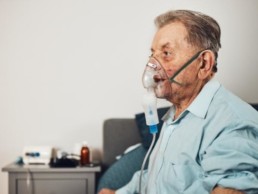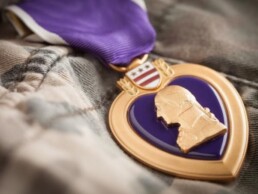Recognizing Our Veterans This Mesothelioma Awareness Day
This September 26th marked the 17-year anniversary of Mesothelioma Awareness Day. This is a day devoted to spreading awareness about this rare and extremely aggressive form of cancer. What many do not know is that mesothelioma is one of the few non-genetic forms of cancer and is usually spoken in tandem with asbestos. Asbestos is the only known culprit of mesothelioma and was heavily used throughout the military from the early 1900s up until the 1980s. Unfortunately, its past use in the military has led to emerging mesothelioma cases today, with roughly 900 new mesothelioma diagnoses annually among our veteran population.
Exposure In The Air Force
For veterans of the Air Force, exposure to asbestos most likely happened on actual Air Force bases. Insulation, wall board, piping, plumbing, sealers, and adhesives were known to contain this carcinogen. Servicemen and women most at risk of exposure were the ones who lived on these bases with their families.
Planes used by the Air Force also contained asbestos in some parts, such as the heat shield, engine, and brake pads. Aircraft mechanics were put at risk as these parts began to wear down and fibers were released into the air. Secondhand exposure was also a risk, as asbestos fibers cling to the clothes. This means that mechanics could have been carrying asbestos off the job site, unknowingly exposing their families when they came home from work for the day.
Exposure In The Coast Guard
Those who served in the Coast Guard were mostly likely to come into contact with asbestos while on shipyards and on ships. Coast Guard Cutters were likely to be harboring asbestos in many different areas of the ship. Pump rooms, boiler rooms, sleeping quarters, and mess halls all could have had asbestos-containing materials (ACMs) present. The close quarters type of living on these vessels allowed for asbestos fibers to travel easily to other areas of the ship, potentially exposing everyone on board. The height of exposure for Coast Guard personnel was during World War II, where usage and production of asbestos was at its peak.
Exposure In The Army
Similar to the Air Force, Army personnel had a high risk of exposure when on Army bases. Insulation, floor tiles, roofing, and cement incorporated this carcinogenic mineral not only because of its fire-resistant qualities, but because it was so cheap. Off-site locations known as Army reserves were also prone to the usage of asbestos. In 2005, the Environmental Protection Agency (EPA) reported that there were still ACMs that needed to be abated from these locations.
Army vehicles also utilized asbestos in some parts that would experience high temperatures and friction. This posed a risk to Army mechanics whose job required them to repair brake pads, gaskets, and clutch plates on vehicles used in combat and transport.
Exposure In The Navy
Navy veterans are the most likely of all military personnel to develop an asbestos-related disease. This is due to the fact that asbestos was most heavily used among this branch of the military. Cruisers, destroyers, aircraft carriers, submarines, and more were often built with ACMs. Asbestos was primarily used in the insulation of these vessels and was also favored because it does not deteriorate easily when in contact with water. The servicemen and women involved in the building, repairing, and retiring of these ships were the ones who most likely were exposed, as the ACMs would degrade overtime.
Exposure In The Marines
Much like the Navy and Coast Guard, veterans of the Marines were also put at risk by being on and working with ships. Marines are often aboard Navy ships being transported to and from conflict areas. While being transported, they carry out maintenance tasks the same as any Navy member would. These duties may involve repairing gaskets or removing insulation, which can disturb and release asbestos. Unfortunately, many of the high-risk ships used throughout World War II and the Vietnam War are still a part of the Navy’s fleet today.
Spreading Awareness
With mesothelioma continuing to affect so many veterans every year, the Purple Heart Foundation believes it is imperative to increase awareness of this disease. This cancer could be diagnosed less, or even disappear, if we are vigilant in protecting ourselves and our military population from asbestos exposure.
Honoring Purple Heart Month
As we begin the month of August, it is our great pleasure to welcome you to
Purple Heart Month!
This month is dedicated to paying our respects to all the brave men and women wounded or killed in combat. The official Purple Heart Day is observed on the 7th day of August each year, commemorating the historic day in 1782 that General George Washington, Commander-In-Chief of the Continental Army, commissioned the first Purple Heart Medal, originally called the Badge of Military Merit.
The Badge of Military Merit is a purple, heart-shaped piece of silk bound with a thin edge of silver with the word merit embroidered in silver across the face. Only 3 Badges of Military Merit were awarded. The Badge of Military Merit was redesigned and re-commissioned in 1932 by General Douglas McArthur in honor of George Washington’s bicentennial birthday. Now known as the Purple Heart Medal – it is the oldest military award, first being awarded to soldiers in World War I and still given to soldiers today.
A presidential order signed in 1942 permitted the Purple Heart Medal to be awarded to all branches of the military including the U.S. Coast Guard. It was World War II, when the qualification to receive the Purple Heart Medal changed to honor those who were wounded or killed in combat – that is why it’s recipients often call it “the medal that nobody wants”. It is unknown how many soldiers actually received it. However, we know that the soldiers listed below are some of the most awarded Purple Heart Recipients in history:
Robert T. Frederick, U.S. Army: World War II (8)
David H. Hackworth, U.S. Army: Korean War (3), Vietnam War (5)
Joe Hooper, U.S. Army, Medal of Honor: Vietnam War (8)
Robert L. Howard, U.S. Army, Medal of Honor: Vietnam War (8)
William Waugh, U.S. Army: Vietnam War (8)
It took the Purple Heart medal many years to evolve into what it is today. Today, on the reverse of the medal, “FOR MILITARY MERIT” is inscribed. The medal itself is made of brass with a gold color to it, and also contains a bust of George Washington and his coat of arms. The purple color represents the blood of all those who have made sacrifices in war, but traditionally it represent the courage of those who serve. The original color of the medal George Washington created was purple, so it was only fitting that it would be used to honor his memory in the new medal.
The Military Order of the Purple Heart (MOPH) was formed in 1932. It is composed exclusively of men and women who have received the Purple Heart Medal and is the only Veteran’s Service Organization whose membership is comprised solely of “combat-wounded veterans”.
The Military Order of the Purple Heart Service Foundation, also known as the Purple Heart Foundation, was later created in 1957 as a non-profit organization. For more than 60 years, the Purple Heart Foundation has solely dedicated itself to funding programs and services that support our nation’s heroes. Donate to show your support of the Purple Heart Foundation and to help us continue to serve our nation’s veterans who have already sacrificed so much.
DONATE


